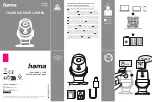
124
広角・超広角レンズのオートフォーカス撮影について
広角・超広角レンズでは、標準クラスのレンズと比べ、下記のような撮影条件にな
りやすく、オートフォーカス撮影時には注意が必要です。
以下をお読みになって、オートフォーカス撮影にお役立てください。
1. フォーカスフレームに対して主要な被写体が小さい場合
122ページ図Aのように、フォーカスフレーム内に遠くの建物と近くの人物が
混在するような被写体になると、背景にピントが合い、人物のピント精度が低
下する場合があります。
2. 絵柄がこまかな場合
123ページ図Bのように、被写体が小さいか、明暗差が少ない被写体になると、
オートフォーカスにとっては苦手な被写体になります。
◆ このような時には・
・
・
1、2のような被写体条件でオートフォーカスが上手く働かない場合、主要被写
体とほぼ同じ距離にある被写体でフォーカスロックし、構図を元に戻して撮影す
る方法が有効です。
また、マニュアルフォーカスに切り換えて、マニュアルでピントを合わせて撮影
する方法もあります。
その他:
お手持ちのカメラの使用説明書で「オートフォーカスが苦手な被写体に
ついて」の説明も参照してください。
Notes on using wide or super-wide angle AF Nikkor lenses
In the following situations, autofocus may not work properly when
taking pictures using wide or super-wide angle AF Nikkor lenses.
1. When the main subject in the focus brackets is relatively small.
As shown in Fig. A (p. 122), when a person standing in front of a distant
background is placed within the focus brackets, the background may be in
focus, while the subject is out of focus.
2. When the main subject is a small, patterned subject or scene.
As shown in Fig. B (p. 123), when the subject is highly patterned or of low contrast,
such as a field covered with flowers, autofocus may be difficult to obtain.
In such situations:
(1) Focus on a different subject located at the same distance from
the camera, then use the focus lock, recompose, and shoot.
(2) Or set the camera’s focus mode selector to M (manual) and
focus manually on the subject.
• Also, refer to “Getting Good Results with Autofocus” in your
camera’s user’s manual.
Summary of Contents for AF-S NIKKOR 14-24mm f/2.8G ED
Page 23: ...23 En ...
Page 49: ...49 Es ...
Page 67: ...67 Nl ...
Page 77: ...77 It ...
Page 112: ...112 ...
Page 113: ...113 ...
Page 114: ...114 ...
Page 115: ...115 ...
Page 121: ...121 ...
Page 128: ...128 ...
Page 129: ...129 ...
Page 130: ...130 ...
Page 131: ...131 ...









































